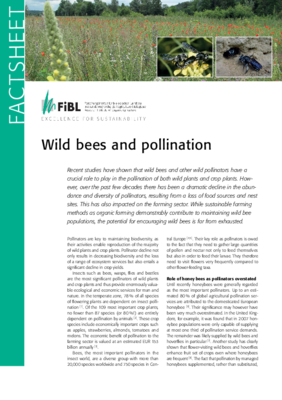Recent studies have shown that wild bees and other wild pollinators have a crucial role to play in the pollination of both wild plants and crop plants. However, over the past few decades there has been a dramatic decline in the abundance and diversity of these pollinators – a development which has also adversely impacted on the farming sector. A new factsheet produced by FiBL summarizes the key findings in this field and provides a list of measures that can be taken to encourage and conserve wild pollinators. This factsheet can be downloaded free of charge at www.shop.fibl.org.
Endangered pollinators
Approximately 80 % of all crop plants rely on pollinators for reproduction. The economic benefit of pollination to the farming sector is estimated at EUR 153 billion annually. About 80 % of this figure had traditionally been ascribed to honeybees. More recent research has shown, however, that honeybees play a minor role in crop pollination, even more so since over recent years a strong decline in beekeeping as well as colony collapse disorder have considerably diminished their role as pollinators in many regions. Yet wild bee populations also exhibit severe decline. Between 25 % and 68% of all wild bee species in central Europe are endangered, with the percentages varying between countries and regions.
Not enough florally-rich habitats and too much intensification
In the course of agricultural intensification over the past fifty years many florally-rich and small-scale habitats were destroyed. Much of today’s agricultural landscape is devoid of natural structures and floral resources. The much-reduced provision of food and nesting resources, as well as the increasing fragmentation of sites rich in floral resources and small-scale habitat features, has led to a strong decline in both the abundance and diversity of wild bee species. The widespread use of insecticides, including systemic insecticides, has resulted in wild bees, honeybees, hoverflies, beetles and many other flower-visitors either being killed or suffering sub-lethal adverse effects on their behaviour, reproduction and brain development. Especially for honeybees the latest research has shown that pesticides may even weaken the bees’ immune response.
Special promotion and conservation measures needed for wild bees
More florally-rich landscapes will be needed in order to halt the decline in wild bee populations; in addition to the instrument of ecological compensation areas already in place in Switzerland, specific pollinator-friendly, flower-rich plots must be established. The focus should primarily be on maintaining habitats rich in floral resources and small-scale features, with food and nesting resources in close proximity and a continuous provision of floral resources from early spring to late summer. Any measures designed to increase the abundance, diversity and distribution of flowering plants and small-scale habitat features well exposed to the sun will increase species diversity and population sizes in wild bees. This will ultimately result in improved pollination of crops and wild plants.
A further promotion measure involves restricting the use of plant protection products to those that have no or only moderate side-effects on non-target organisms such as insects, other small fauna and vertebrates. This can best be achieved in a matrix of heterogeneous land use in combination with less intrusive production methods such as low-input farming, organic arable cropping, and no chemical inputs. Considerable synergies can be achieved by combining wild bee promotion with honeybee protection and the promotion of agricultural beneficials.
Organic farming can encourage wild bees
Organic farming systems are generally of benefit to the conservation and support of wild bees. This is due in part to the following practices:
- No applications of chemical-synthetic pesticides.
- No applications of chemical fertilizers.
- More frequent inclusion of grass-clover leys in arable crop rotations, with the legumes supporting a range of bumblebee and other wild bee species, offering them ample food.
- Non-chemical weed control measures contributing to a flower-rich arable flora including important sources of pollen and nectar.
- Extensive grassland management resulting in more florally-rich, less grass-dominated swards and ultimately in greater numbers of insect-pollinated plants.
Further information
Contact
New factsheet
The FiBL factsheet summarizes current scientific knowledge on the importance of wild bees in the pollination of both wild plants and crop plants. It sets out the currently known causes of the decline in wild bees, outlines the impacts of organic farming, and lists measures which should be taken in addition to the approaches adopted to date with a view to encouraging and conserving wild pollinators. This factsheet can be downloaded free of charge at www.shop.fibl.org.
Links
- fibl.org: Subject Biodiversity
- shop.fibl.org: Factsheet "Wild bees and pollination"




